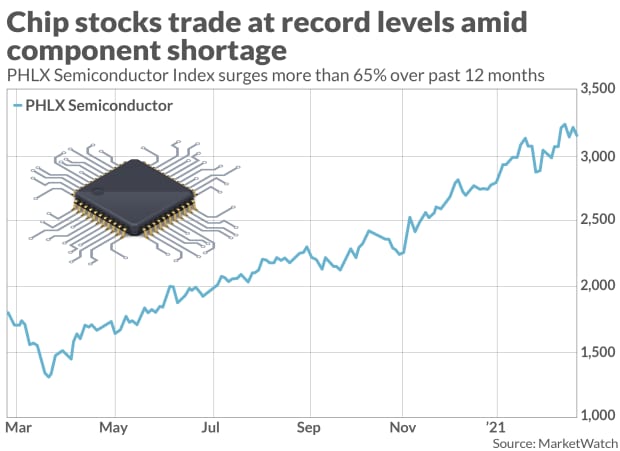Worldwide chip shortage expected to last into next year, and that’s good news for semiconductor stocks
A global shortage of semiconductors has pushed chip stocks to record highs, and analysts expect that chips will continue to be in short supply at least through the end of the year as COVID-19 pushes the world further into the digital realm and the industry struggles to keep up with demand.
Chips have been hard to come by for auto makers and consumers, causing difficulties in a range of industries. The cause seems to be a combination of increased demand as people scooped up electronics during the COVID-19 pandemic, limited manufacturing capacity to meet that demand, and the U.S.-China trade war.
Maribel Lopez, principal analyst at Lopez Research, told MarketWatch in an interview the chip industry is facing “a perfect storm” of demand and supply issues that is unlikely to resolve soon.
“Unless we have a major economic meltdown, which is obviously possible, one of the things that’s happening right now is that almost anything you buy is going to have a chip in it,” Lopez said. “You can’t buy a dumb product.”
While high demand for mobile-device chips in 2020 was expected, the surge in demand for PC-based chips was not, she said. The trend of shrinking chips down to where they can fit in places they haven’t been able to fit before has made the manufacturing process more complex, Lopez noted. The pandemic took those trends and placed an added level of volatility on the supply chains and manufacturing practices dealing with them.
The full impact of the chip shortage, however, didn’t hit home to the wider market until General Motors Co. GM,
For more: Semiconductor stocks are hot, and these numbers say they have more room to run
Chip stocks have soared to all-time highs. The PHLX Semiconductor Index SOX,

Analysts believe there could be more gains ahead, though, as demand sends prices higher and boosts companies throughout the semiconductor space. Even as stock fundamentals appear stretched thin, Sur said “we believe semi companies are shipping 10% to 30% BELOW current demand levels and it will take at least 3-4 quarters for supply to catch up with demand and then another 1-2 quarters for inventories at customers/distribution channels to be replenished back to normal levels.”
Susquehanna Financial analyst Christopher Rolland recently said he expects chip shortages will only get worse heading into the spring. Lead times, or the amount of time an order is placed between it delivery, for semiconductors are entering a “danger zone” of above 14 weeks, the longest they’ve been since the last chip boom of 2018, Rolland said.
See also: Semiconductor stocks to buy in 2021 after price dips, according to B. Riley
While that may be good in the short term for chip suppliers and makers, with some companies estimating demand outstripping supply for several quarters, in the long run it could backfire if not managed well, Rolland said.
The chip industry still remembers what happened less than three years ago when it was drowning in a glut of oversupply. Back then, customers overbought supplies of chips to lock in lower prices because prices had soared in the 2018 chip boom, causing a steep drop in demand, leaving chip makers with large inventories and plummeting stock prices. Nvidia Corp. NVDA,
Those companies are doing what they can to avoid a repeat of the pain that came at the end of the 2018 boom and resulting shortage. Nvidia, for example, said it hoped to ease shortages of gaming cards by launching a chip designed for cryptocurrency mining as cryptocurrencies like bitcoin BTCUSD,
While claims of “this time it’s different” should always be taken with a grain of salt, it may very well be different this time around given the unprecedented mix of factors the world has gone through over the past year. Stifel analyst Matthew Sheerin, who follows tech supply chain issues, is more concerned with continued supply-chain disruptions than he is over-ordering.
“We’ve heard from countless component suppliers and distributors about elevated book-to-bill levels and growing backlog, typically a ‘double-ordering’ red
flag,” Sheering said.
“We don’t see any major correction on the horizon, given ongoing supply constraints as well as continued optimism about improving demand in 2H21,” the Stifel analyst said. “We remain more concerned with continued supply disruptions, and increased materials costs, than we do an imminent multi-quarter inventory correction.”
MarketWatch Premium: 11 semiconductor stocks expected to rise up to 47% over the next year
Chip-equipment suppliers seem confident that chip manufacturers will build out their capacity because of the shortage and next-generation designs that won’t be well served by existing fabs. Applied Materials Inc. AMAT,
Case in point, Taiwan Semiconductor Manufacturing Co. TSM,
AMD said it expects a strong 2021 earlier this year, and announced new laptop and data-center chips. Qualcomm Inc. QCOM,
Supply shortages hitting traditional industries, instead of just making it harder for gamers to get the latest console or graphics card, has raised the urgency of addressing the shortage. Amid growing concerns from industry leaders, Biden administration has reportedly drafted an executive order that review critical supply chains that affect U.S. manufacturing, particularly those involving chips and high-capacity batteries.




